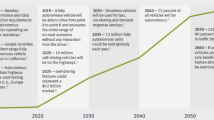Abstract
The evolution of cars has been notorious over the years, since the first four-wheeled car, that emerged in mid-1891 up to the present day, where it’s already possible to see semi-autonomous cars.
Currently, and with the constant automotive evolution, the cars practically drive themselves, without the need for users go with maximum attention in several situations. It was around 1980 that the first autonomous cars appeared, such as the NavLab which became a big innovation, evolving also the automotive industry and thus beginning the season of studies on autonomous cars. Nowadays Tesla is the great brand that innovated the auto-motive future, being that, is not completely autonomous, but in many situations the driver also becomes the passenger. It’s important to refer that Tesla until to these days only makes semi-autonomous cars, being which, several other tests are being conducted, not only by Tesla, but also by other big brands, like the Google, which is developing a totally autonomous car. Fully autonomous cars are still a big innovation, both for design, like for engineering, as it’s essential to gather the conditions so that these can be placed on the market, without any hindrance and protecting the Human from any dangers that may raise, and for that very reason, it’s necessary understand and study this new “era”. Throughout this dissertation several important aspects for the realization and creation of a cockpit for the completely autonomous car will be analyzed, by analyzing users, the cars, but also the legislation and ongoing tests about the subject. To deal with this new “era” in which cars can be shared, and drive themselves, it’s essential to understand how this can be possible, what steps are needed for implementation, and what the design and engineering of the fully autonomous cars might look like. The aspects of these vehicles will be analyzed as well as the users. Ultimately, virtual reality tests will be performed, to understand what the interior of the car will be like and understand how users behave inside an autonomous car.
Access this chapter
Tax calculation will be finalised at checkout
Purchases are for personal use only
Similar content being viewed by others
Notes
- 1.
Blind spots are the area around the vehicle that cannot be seen directly, or through the rear-view mirrors, while driving (Paulo 2015).
References
Aguiar, C.: A new era will bring electric and autonomous vehicle through NA app. Portugal MOBI summit (2021). https://portugalms.com/en/a-new-era-will-bring-electric-and-autonomous-vehicles-through-an-app/. Accessed 11 Oct 2021
Alecrim, E.: Primeiro protótipo funcional do carro autónomo do Google está pronto. Tecnoblog. https://tecnoblog.net/171745/prototipo-carro-autonomo-google/. Accessed 15 Oct 2021
Allthecars: Mercedes presents autonomous car prototype. All the Cars (2015). https://allthecars.wordpress.com/2015/01/07/mercedes-apresenta-prototipo-de-carro-autonomo/
Baudrillard, J.: The consumer society (1995). BAUDRILLARD_1995_A_sociedade_de_consumo.pdf. Accessed 15 Oct 2021
Bellis, M.: History of the automobile ThoughtCo (2019). https://www.thoughtco.com/automobile-history-1991458?terms=History+Of+The+Automobile. Accessed 21 Nov 2021
Bruce, C.: Panasonic autonomous car. Motor1 (2017). https://www.motor1.com/news/132914/panasonic-autonomous-cabin-concept-ces/
Drive Safety: Evolution of the Automobile (2020). https://www.idrivesafely.com/defensive-driving/trending/evolution-automobile. Accessed 22 Nov 2021
Felipe, C.: What are the 5 levels of autonomous cars and what do they mean. Connected World (2018). https://mundoconectado.com.br/artigos/v/5004/quais-sao-os-5-niveis-de-carros-autonomos-e-o-que-significam
Hall, C.: Autonomous cars: levels of autonomous driving explained. Pocket-lint (2020). https://www.pocket-lint.com/pt-br/carros/noticias/143955-sao-explicados-os-niveis-de-direcao-autonoma. Accessed 22 Nov 2021
Henrique, M.: Autonomous cars: one solution or one more problem? Blastingnews (2017).https://br.blastingnews.com/tecnologia/2017/01/carros-autonomos-uma-solucao-ou-mais-um-problema-001398121.html. Accessed 02 Dec 2021
Joshi, N.: How virtual reality can improve autonomous vehicles. BBNTIMES. How Virtual Reality Can Improve Autonomous Vehicles (2021). http://bbntimes.com
Lusa: Autonomous cars should only arrive in Portugal in 2025. TSF Rádio de Notícias (2021). https://www.tsf.pt/futuro/carros-autonomos-so-devem-chegar-a-portugal-em-2025-13390062.html. Accessed 02 Dec 2021
Mapfre: What is an autonomous car. https://www.mapfre.com.br/para-voce/seguro-auto/artigos/o-que-e-um-carro-autonomo/. Accessed 03 Dec 2021
Mitti: The advantages and challenges of autonomous cars (2020). http://www.mitti.com.br/as-vantagens-e-desafios-dos-carros-autonomos/
Nakata Automotiva: Autonomous cars: complete guide to understand everything about the subject (2019). https://blog.nakata.com.br/carros-autonomos-guia-completo-para-entender-tudo-sobre-o-assunto/. Accessed 03 Dec 2021
Nissan: The Nissan X motion, Nissan (2018). https://www.nissanusa.com/vehicles/future-concept/xmotion-autonomous-suv.html
Ondruša, J., et al.: How do autonomous cars work? ScienceDirect (2020). https://www.sciencedirect.com/science/article/pii/S2352146520300995. Accessed 06 Dec 2021
Piper, K.: It’s 2020. Where are our self-driving cars? Vox, 28 de fevereiro 2020. https://www.vox.com/future-perfect/2020/2/14/21063487/self-driving-cars-autonomous-vehicles-waymo-cruise-uber. Accessed 14 Dec 2021
PPLWARE: Samsung shows off its digital cockpit for autonomous electric cars (2021). PPLWARE: https://pplware.sapo.pt/motores/samsung-mostra-o-seu-cockpit-digital-para-carros-eletricos-autonomos/
Universo Lambda: Cars: vision of the future (2017). UL: https://universolambda.com.br/carrosvisao-de-futuro/
Vitor, M.: Autonomous cars - discover the 5 driving levels (2018). PPLWARE: https://pplware.sapo.pt/motores/carros-autonomos-conheca-os-5-niveis-de-conducao/, Accessed 16 Dec 2021
Volksvagen: SEDRIC- Generous interior with lounge atmosphere despite compact dimensions (2017). VW: https://www.volkswagen-newsroom.com/en/sedric-concept-car-3552
Volksvagen: Volksvagen ID. LIFE, concept car (2021). VW: https://www.volkswagen-newsroom.com/en/the-id-life-world-premiere-7469
Volvo: A new way to travel. Volvo (2021). https://www.volvocars.com/intl/cars/concepts/360c
Yamany, P.: Economy class, business class and first class: understand the differences (2019). Skyscanner: https://www.skyscanner.com.br/noticias/dicas/classe-economica-classe-executiva-e-primeira-classe-entenda-as-diferencas
Acknowledgements
This work is financed by national funds through FCT - Fundação para a Ciência e a Tecnologia, I.P., under the Strategic Project with the reference UIDB/04008/2020.
Author information
Authors and Affiliations
Corresponding author
Editor information
Editors and Affiliations
Rights and permissions
Copyright information
© 2022 The Author(s), under exclusive license to Springer Nature Switzerland AG
About this paper
Cite this paper
Reis, D., Filgueiras, E. (2022). Development the Cockpit of the Autonomous Cars. In: Soares, M.M., Rosenzweig, E., Marcus, A. (eds) Design, User Experience, and Usability: Design Thinking and Practice in Contemporary and Emerging Technologies. HCII 2022. Lecture Notes in Computer Science, vol 13323. Springer, Cham. https://doi.org/10.1007/978-3-031-05906-3_29
Download citation
DOI: https://doi.org/10.1007/978-3-031-05906-3_29
Published:
Publisher Name: Springer, Cham
Print ISBN: 978-3-031-05905-6
Online ISBN: 978-3-031-05906-3
eBook Packages: Computer ScienceComputer Science (R0)




